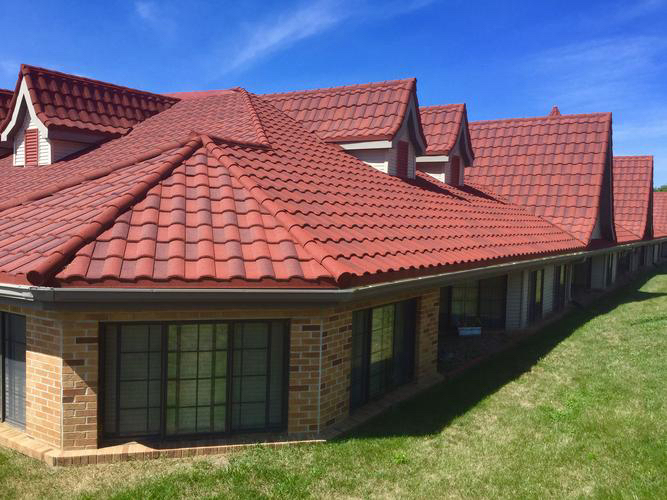
Stone-coated metal tiles and color steel tiles are two common roofing materials widely used in construction. While they both serve the purpose of protecting buildings from the external environment, they differ significantly in terms of material, appearance, performance, durability, and other aspects. Below is a detailed comparison of these two materials.
1. Material and Structure
Stone-coated metal tiles are typically made from an aluminum-zinc alloy steel plate as the base material, covered with a layer of natural stone chips and an acrylic resin coating. Their internal structure includes a high-strength steel plate, an intermediate anti-corrosion coating, and an outer layer of stone chips. This structure not only gives stone-coated metal tiles high corrosion resistance but also greatly enhances their aesthetic appeal.
Color steel tiles, on the other hand, are made from color-coated steel plates, usually with a single-layer structure. The base material is generally cold-rolled steel, with a colored coating applied to the surface to enhance its weather resistance and appearance. The structure of color steel tiles is relatively simple, relying mainly on the surface coating to prevent rust and corrosion.
2. Appearance and Decorative Features
Stone-coated metal tiles offer a variety of appearances, with natural stone chips on the surface that can create different colors and textures, mimicking the look of natural stone or traditional tiles. These tiles typically have a strong three-dimensional effect and are highly decorative, making them ideal for upscale residences, villas, and commercial buildings.
Color steel tiles have a simpler appearance, usually in flat or corrugated forms. While they come in various colors, their overall visual effect is more uniform. They are more suitable for industrial buildings, warehouses, and other functional structures.
3. Performance and Durability
Stone-coated metal tiles, with their multi-layered structure and high-quality materials, provide excellent wind resistance, fire resistance, thermal insulation, and noise reduction. Their strong corrosion resistance is especially notable in coastal areas and regions with acid rain. The lifespan of stone-coated metal tiles is typically over 50 years, with low maintenance costs.
Color steel tiles offer decent performance, with good wind and fire resistance, but due to their simpler structure, they have relatively weaker corrosion resistance. In humid and corrosive environments, they are prone to rust, fading, and other issues. The lifespan of color steel tiles is usually 20-30 years, requiring regular maintenance.
4. Cost and Budget
Stone-coated metal tiles are more expensive due to their complex materials and manufacturing processes. Although the initial cost is higher, their long lifespan and low maintenance requirements offer good long-term value.
Color steel tiles are more affordable, making them suitable for projects with limited budgets. While the initial investment is lower, their shorter lifespan may lead to higher maintenance and replacement costs over time.
5. Installation and Application Scenarios
Installing stone-coated metal tiles is more complex and requires professional technicians, but they are suitable for various complex roof shapes, especially in high-end buildings and places with higher aesthetic requirements.
Color steel tiles are easier to install, with faster construction speed, making them ideal for large flat roofs and industrial and commercial buildings where appearance is less critical.
Conclusion
Both stone-coated metal tiles and color steel tiles have their advantages and disadvantages, making them suitable for different building needs. Stone-coated metal tiles, with their superior performance and high-end decorative effects, are ideal for villas, upscale residences, and commercial buildings. Color steel tiles, with their lower cost and ease of installation, are widely used in industrial, storage, and functional buildings. When choosing between them, it’s important to consider the building type, budget, and environment, and make a decision based on the material’s performance and lifespan.


